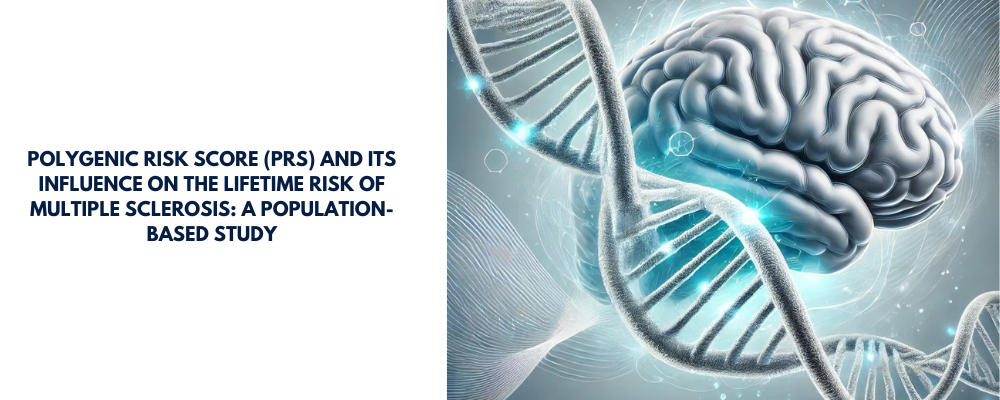Polygenic Risk Score (PRS) and Its Influence on the Lifetime Risk of Multiple Sclerosis

Multiple sclerosis (MS) is a complex immune-mediated neurodegenerative disorder characterized by an interplay of genetic and environmental factors. Although more than 200 genetic variants have been linked to MS susceptibility through genome-wide association studies (GWAS), the direct influence of these genetic markers on the lifetime risk of developing MS remains unclear. A recent study by Floor C. Loonstra and colleagues published in Neurology (2024) aimed to address this gap by investigating the association between polygenic risk scores (PRS) and the lifetime risk of MS in a population-based birth-year cohort from the Netherlands.
Study Overview
This study utilized data from the Project Y cohort, which includes persons with MS (pwMS) and matched controls from the Amsterdam Dementia Cohort, all born between 1963 and 1969. The researchers calculated MS-PRS for 285 pwMS and 267 control participants, with the primary goal of assessing how genetic risk, as quantified by PRS, influences the lifetime risk of developing MS. Participants were grouped into deciles based on their PRS, allowing the study to estimate lifetime risk across varying levels of genetic susceptibility.
Key Findings
Lifetime Risk of MS: The findings demonstrated a striking difference in the lifetime risk of MS between individuals with high and low genetic risk scores. Among women, those in the top 10% of the genetic risk distribution had a 1 in 92 chance of developing MS, compared to a significantly lower risk of 1 in 2,739 for women in the lowest 30% of genetic risk. For men, the difference was similarly pronounced, with a 1 in 293 risk in the top 10% of the PRS distribution and a 1 in 7,900 risk in the lowest 30%.
Sex Differences: The study confirmed that MS is more prevalent in women, with the lifetime risk estimates showing that women are disproportionately affected compared to men across all genetic risk categories. This highlights the importance of considering sex-specific factors in MS risk assessment.
Implications for MS Diagnosis and Research
The results of this study underscore the potential utility of PRS in supporting MS diagnosis, particularly in distinguishing between individuals with high and low genetic risk. A high PRS could reinforce a diagnosis of MS in patients with ambiguous symptoms, while a low PRS may serve as a red flag to consider alternative diagnoses. This could prevent misdiagnosis of conditions that mimic MS, ensuring more accurate and timely treatment.
However, it is important to note that this study’s findings are specific to individuals of European ancestry, as the PRS was derived from GWAS studies that primarily included European populations. The application of this genetic risk model to other populations may yield different results due to variations in genetic architecture and disease susceptibility across ancestries.
Study Limitations and Future Directions
While the study provides valuable insights into the genetic underpinnings of MS, it is not without limitations. The cohort was restricted to individuals born in 1966 in the Netherlands, meaning that the findings may not be generalizable to other birth years or populations. Additionally, the study did not account for competing risks of death, which could influence lifetime risk estimations.
Future research could focus on extending the PRS model to more diverse populations and exploring how environmental factors interact with genetic risk to influence MS susceptibility. Understanding these complex interactions could pave the way for more personalized approaches to MS prevention and treatment.
Conclusion
The association between PRS and the lifetime risk of developing MS, as demonstrated by Loonstra et al., marks a significant step forward in understanding the genetic factors that contribute to MS susceptibility. This study highlights the potential of PRS as a diagnostic tool, offering a more nuanced approach to risk assessment and early detection of MS. As research continues to evolve, the integration of genetic, environmental, and clinical factors will be key to unlocking the full potential of personalized medicine in MS care.
By integrating genetic risk into clinical practice, healthcare providers may be better equipped to identify individuals at higher risk of MS and intervene earlier, potentially altering the course of the disease.
Reference:
Loonstra, F. C., Álvarez Sirvent, D., Tesi, N., Holstege, H., Strijbis, E. M. M., Salazar, A. N., Hulsman, M., Van Der Lee, S. J., & Uitdehaag, B. (2024). Association of Polygenic Risk Score With Lifetime Risk of Developing Multiple Sclerosis in a Population-Based Birth-Year Cohort. Neurology, 103(7), e209663. https://doi.org/10.1212/WNL.0000000000209663
